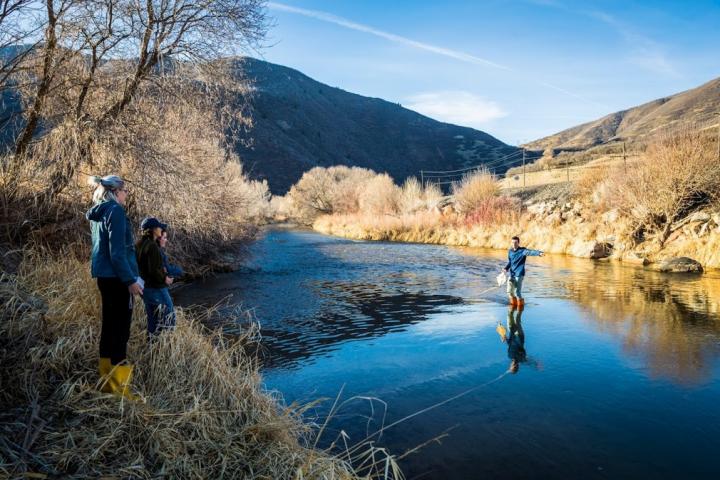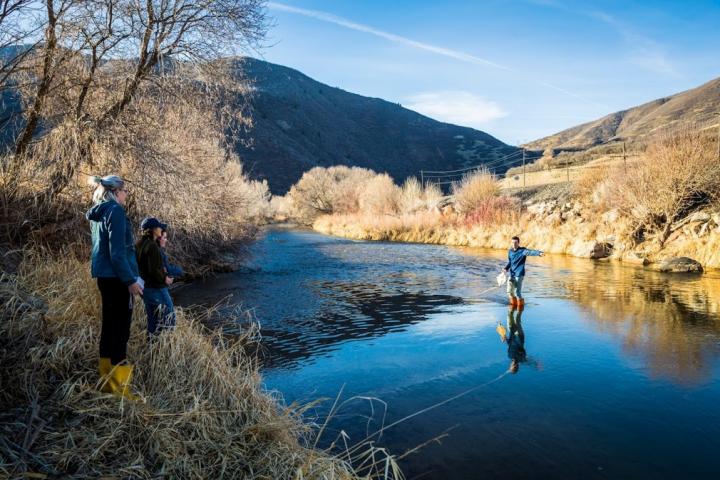
Credit: Courtesy of MSU
EAST LANSING, Mich. – Many people see the carbon cycle as vertical – CO2 moving up and down between soil, plants and the atmosphere.
However, new Michigan State University research published in the current issue of Geophysical Research Letters, adds a dimension to the vertical perspective by showing how water moves massive amounts of carbon laterally through ecosystems – especially during floods. These findings — which analyzed more than 1,000 watersheds, covering about 75 percent of the contiguous U.S. – have implications for climate change and water quality.
Carbon in the environment, specifically dissolved organic carbon or DOC, is a master variable that influences many of our planet's fundamental processes, such as water chemistry, greenhouse gas emissions and pollutant transport across land and water, said Jay Zarnetske, MSU earth and environmental scientist and the study's lead author.
"When water flows through ecosystems, it picks up organic carbon from plants and soils, and in many cases, water determines whether the ecosystem is a net carbon source or sink," he said. "The massive amount of carbon that leaks out of ecosystems as DOC is about as big as the net amount of carbon taken up from the atmosphere each year. So accurate accounting is crucial when managing the 'carbon bank account.'"
DOC in rivers is like making tea, Zarnetske added.
"You start with relatively clear water falling as precipitation, and then the organic carbon in the landscape gets leached into the water," he said. "This tea then gets flushed to streams during floods, often turning the water brown."
Zarnetske's new work suggests a better way to account for the carbon leaving ecosystems as DOC by including data from flood events. Citing logistical and safety concerns, scientists typically give rivers wide berth during floods. As a result, researchers know less about DOC behavior during floods. When water is flowing fast and brown, though, is when the most carbon is being transported out of most watersheds. In other words, this is a time when more sampling is needed.
What surprised the team of scientists is that floods readily flush carbon from landscapes in diverse ecosystems across North America, spanning from Michigan forests to the Sonoran Desert. They initially thought the DOC would be diluted by floods in many parts of the U.S. Floods, however, lead to the release of large amounts of DOC – or stronger tea, metaphorically speaking – from almost all environments in a relatively short time.
"We knew that DOC went up during floods in some areas, but we were surprised to see the same pattern in the vast majority of watersheds all across the country," Zarnetske said. "Deserts don't have as much DOC as deciduous forests, but when you have an event like a flash flood, the process is the same, and the torrents of water are chock full of carbon."
Another important confirmation from the study's massive data set was the significant role wetlands play in our watersheds. The DOC flushing behavior across the U.S. was primarily related to the acreage of wetlands in a watershed. Wetlands act as buffers or storage zones for DOC in watersheds. If floodwaters rise, water and DOC in the wetlands closest to the river can rapidly spill over.
Consequently, where natural wetlands are located within the watershed is important. Draining natural wetlands and "trading them" for another nearby swamp or building an artificial wetland might look good on paper, but it's going to affect an area's ability to store and release carbon, Zarnetske added.
"Wetlands are major controls for carbon balance and water quality, and they're also some of the most vulnerable landscapes," he said. "If you move them, you're changing a region's plumbing and the chemistry."
For this research, the scientists used data from across the U.S., but they didn't wade in a single stream or swamp. Their results came from scads of data collected over decades by state and federal government agencies, primarily the U.S. Geological Survey. The dataset's sheer size can be intimidating, and mastering the skills needed to tease out its secrets is daunting. However, it is a true treasure trove of information. While collecting this long-term data may not seem as exciting as conducting new experiments, the historic data are valuable and their value only grows with time, Zarnetske said.
"It's not flashy, but it's powerful data," he said. "These data were being collected long before we knew of computers and methods powerful enough to analyze it all. It's another example of how long-term data collections are key to discoveries and worthy of continued funding."
And such massive datasets play into MSU's strengths, he added.
"Among MSU's strong suits are data-intensive research, macrosystems ecology and interdisciplinary research," Zarnetske said. "Our team leveraged this publicly available dataset in a novel way to refine many longstanding theories enabling better management of carbon balances, wetlands and other water-quality issues."
###
The research team for this study included Ben Abbott, former MSU earth and environmental scientist, now at Brigham Young University; Martin Bouda, Czech University of Life Sciences; and James Saiers and Peter Raymond, Yale School of Forestry and Environmental Studies.
Michigan State University has been working to advance the common good in uncommon ways for 160 years. One of the top research universities in the world, MSU focuses its vast resources on creating solutions to some of the world's most pressing challenges, while providing life-changing opportunities to a diverse and inclusive academic community through more than 200 programs of study in 17 degree-granting colleges. For MSU news on the Web, go to MSUToday. Follow MSU News on Twitter at twitter.com/MSUnews.
Media Contact
Layne Cameron
[email protected]
@MSUnews
http://msutoday.msu.edu/journalists/
Original Source
http://go.msu.edu/BRH http://dx.doi.org/10.1029/2018GL080005





